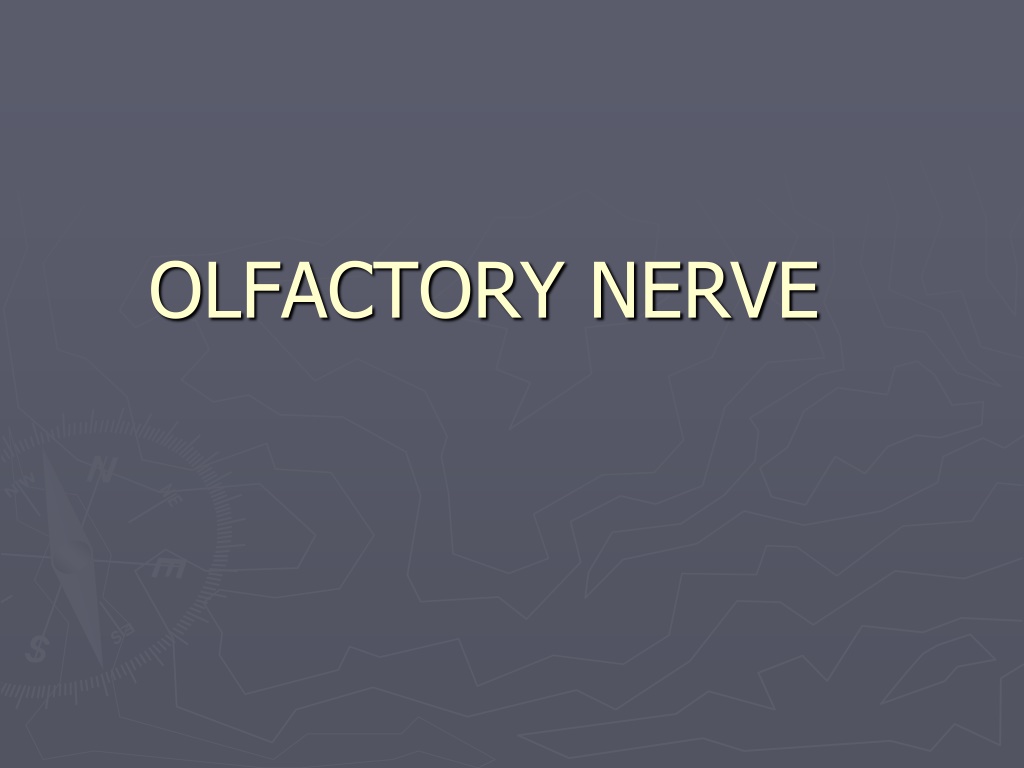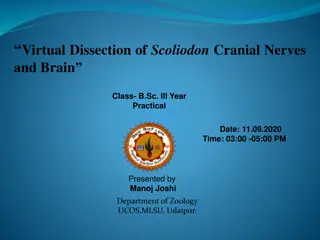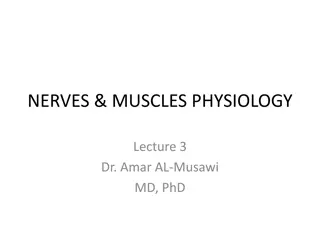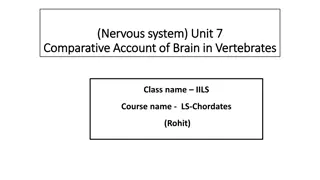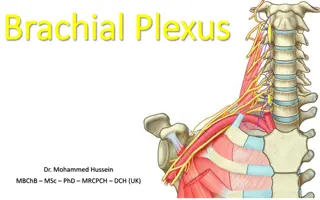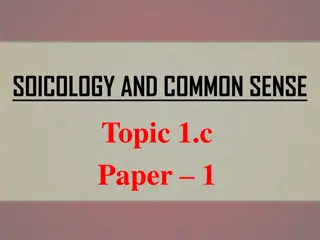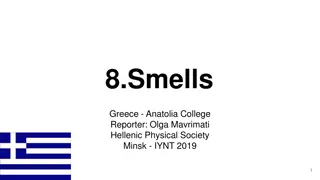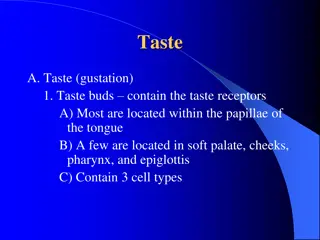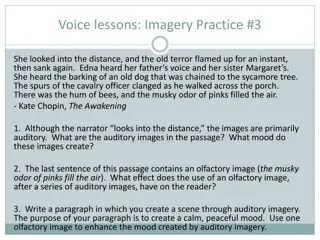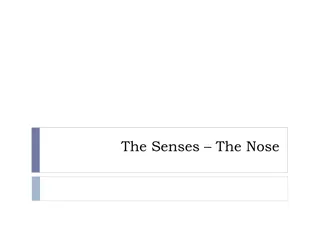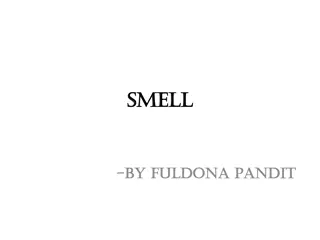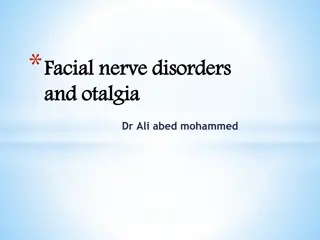Exploring the Olfactory Nerve and Its Role in the Sense of Smell
The olfactory nerve, the first cranial nerve, plays a crucial role in our sense of smell. It is unique for its ability to regenerate, with basal cells facilitating this process. The olfactory system is responsible for detecting odors and is essential for various behaviors in mammals. This system consists of peripheral and central components, involving specialized cells in the olfactory epithelium. Understanding the structure and function of the olfactory nerve sheds light on how we perceive and react to different scents.
Download Presentation

Please find below an Image/Link to download the presentation.
The content on the website is provided AS IS for your information and personal use only. It may not be sold, licensed, or shared on other websites without obtaining consent from the author. Download presentation by click this link. If you encounter any issues during the download, it is possible that the publisher has removed the file from their server.
E N D
Presentation Transcript
Introduction First cranial nerve One of the two cranial nerves which doesn t course through the posterior fossa Only neurons which can regenerate (basal cells) Only sensation which is not processed in the thalamus directly
Overview of olfactory system Sensory system used for smell Represents one of the oldest sensory modalities in the phylogenetic history of mammals Less developed in humans than in other mammals such as rodents. As a chemical sensor, the olfactory system detects food and influences social and sexual behavior. 2 distinct parts- Main- for volatile air-borne stimuli Accessory- for fluid-phase stimuli Often spoken along with the gustatory system as the chemosensory senses Mechanism-Peripheral and central
Peripheral component External stimulus( odour) Olfactory receptors in olfactory epithelium Transduction of receptor activation into electric signals Signals travel along the olfactory nerves (part of peripheral) End in olfactory bulb ( part of central)
Central component Olfactory bulb Medial and lateral olfactory striae Terminal areas
First order- Bipolar sensory cells in the olfactory epithelium Second order- Mitral and tufted cells in the olfactory glomeruli Third order- Neurons in the olfactory cortex
Olfactory epithelium Specialised epithelial tissue inside the nasal cavity that is involved in smell It is about 1 cm2 on each side and lies in the roof of nasal cavity around 7 cm above and behind the nostrils Part of the olfactory system directly responsible for detecting odors 3 types of cells- olfactory, supporting, basal cells
Cells Olfactory cells- Bipolar cells which congregrate to form the olfactory nerve Supporting/ sustentacular cells- metabolic and physical support to olfactory cells Basal cells- STEM CELLS capable of differentiating into either of the two. Their constant division leads to olfactory epithelial regeneration every 2-4 weeks Can be injured by- Toxic fumes/physical injury/?nasal sprays
Olfactory nerves Not a single nerve Instead, a collection of many sensory nerve fibers that extend from the olfactory epithelium to the olfactory bulb, passing through the many openings of the Cribriform plate of the Ethmoid bone; a sieve-like structure. The olfactory nerve is the shortest of the twelve cranial nerves and only one of two cranial nerves (the other being the optic nerve) that do not join with the brainstem.
Olfactory bulb The olfactory bulb lies inferior to the basal frontal lobe. The olfactory bulb is a highly organized structure composed of several distinct layers and synaptic specializations- most important being Mitral and tufted cells
Olfactory tract Projections of the mitral cells to the olfactory cortex Divide into medial and lateral olfactory striae Some fibres decussate in the anterior commisure Medial strial fibres contact the anterior olfactory nucleus and septal area Lateral striae end in the third order neurons of the olfactory cortex Third order neurons in turn send projections to- Dorso-medial nucleus of thalamus Basal forebrain Limbic system
Olfactory cortex Pyriform lobe includes olfactory tract, uncus and ant part of parahippocampal gyrus Primary olfactory cortex- pre-pyriform and periamygdaloid areas Secondary cortex- entorrhinal area
Olfactory abnormalities Terminologies used Anosmia - Absence of smell sensation Hyposmia - Decreased sensation Hyperosmia- Overly acute sense of smell Dysosmia Impairment or defect in sense of smell Cacosmia - Sensation of a bad or foul smell Coprosmia- cacosmia with fecal odour Parosmia Perversion or distortion of smell Phantosmia- Perception of an odour that is not real Olfactory agnosia- Inability to identify detected odours
Testing of the function Use common odours- coffee, lemon, peppermint, soap etc NEVER USE IRRITANT ODOURS- such as ammonia, as it stimulates the V th nerve instead of I cr n Make sure that nasal passages are open and pt doesn t have local nasal pathology Patient must close his eyes and asked to smell through one nostril after another Points to note- Whether he can detect any odour/not Whether he can identify the correct odour Is the intensity symmetrical on both sides
Perception more important than identification Perception indicates continuity of olfactory pathways Identification indicates intact cortical function as well Lesion central to the decussation never causes anosmia such as lesion of olfactory cortex Appreciation of presence of smell is enough for exclusion of anosmia.
Applied aspect History- Enquire about Past head injury Smoking Recent URTI Systemic illness Toxins/medications/illicit drugs Most common causes- URI Trauma Idiopathic
Neurologic causes of anosmia Lesions of the orbital surface of brain- Sphenoid ridge/ olfactory groove meningiomas Frontal lobe gliomas Cranio-cerebral trauma with damage to the cribriform plate Damage due to excessive retraction of frontal lobes Temporal lobectomies ( pt cant identify) Foster-Kennedy syndrome- Anosmia+ I/L optic atrophy (due to direct compression)+ C/L papilloedema ( as ICP rises) In orbito-frontal tumours- olfactory groove meningiomas Pseudo-FK syndrome- Optic atrophy+ C/L papilloedema In ant optic n ischemia Mass causing asymmetrical compression of optic nerves
Other causes Drugs- Antihistamines/ prpylthiouracil/antibiotics Toxins-cadmium/toulene Vit def- A,B6,B12 Alzheimer s/ Parkinson s disease/ Multiple sclerosis Conversion disorder Kallman Syndrome- Hereditary disorder (X-linked) Hypogonadism + anosmia.
Olfactory hallucinations Psychosis Lesion of central olfactory system-neoplastic/ vascular Uncinate fits- Complex partial/ temporal lobe seizures Usually preceded by an olfactory/gustatory area that is often disagreeable Often accompanied by chewing movements Seizure focus- MEDIAL TEMPORAL LOBE No objective loss of smell interictally
